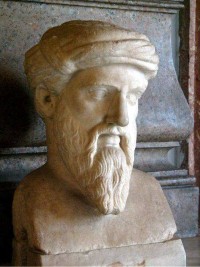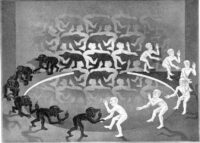 Of all pursuits, mathematics may be the most remarkable. I’m not talking about the simple mathematics of calculating the tip on a restaurant tab; that type of calculation is the simple arithmetic of utility. I’m talking about the mathematics of theoretical physics, a realm reflecting the haziness and uncertainty of quantum mechanics and the strange worlds it conjures up.
Of all pursuits, mathematics may be the most remarkable. I’m not talking about the simple mathematics of calculating the tip on a restaurant tab; that type of calculation is the simple arithmetic of utility. I’m talking about the mathematics of theoretical physics, a realm reflecting the haziness and uncertainty of quantum mechanics and the strange worlds it conjures up.
The work of Isaac Newton, and for that matter Albert Einstein, employ the math of “classical physics.” The mathematics of classical physics deals with movement and gravity of observable large objects; it’s complicated, but not nearly as complicated as the mathematics of “quantum physics,” which deals with theoretical movement and gravity at the sub-atomic scale. It actually was Einstein who began to tip the scientific scale in favor or the validity of quantum physics, though he famously rejected the implications of his own work when he declared that “God does not play dice with the universe.” The uncertainty of quantum physics was too much for Einstein.
The closest the mathematics of quantum physics can get to certainty is probability. In the quantum world of the very, very small, all-and-everything is possible, though probabilities vary widely. Moreover, the mathematics of quantum physics is theoretical and cannot always be verified through the science of experiment and observation. Remarkably, however, those theories which can be experimentally tested have always been verified correct. In this respect, the mathematics of quantum physics has so far been infallible.
This infallibility means that purely theoretical physics, physics which cannot be tested due to technological, scientific limitations, nonetheless provides a window into what’s possible through mathematical analogy, and in the language of quantum physics, what’s probable. If the mathematical formula is logically correct and its calculations performed according to the rules, then its predictions about the quantum world also are likely to be correct
Higher mathematics, the mathematics of that which we cannot fully observe but can describe symbolically in a way which can be calculated, describes the building blocks of existence, the foundations from which all-and-everything arises. Using this tool, theoretical physicists now explicate the workings of the very smallest and largest bodies in the universe, from sub-atomic quarks, bosons and the recently verified Higg’s Field to super-massive black holes like the one at the center of our Milky Way Galaxy. Mathematics predicts outcomes, and as technology develops, those outcomes can be observed and verified.
Many of the predictions of quantum physics are impervious to common sense. We cannot visualize space of nine dimensions, but the mathematics of String Theory requires them. We cannot penetrate a Black Hole, but theoretical physicists use mathematics to describe it. We are witness to a remarkable convergence: the imaginative reach of the insightful human mind combined with the observational tools to test the theories which emerge from it. One can only hope we properly respect this awesome power.
Just as Pythagoras, 495-570 B.C. (pictured above), suggested many thousands of years ago, mathematics is a key which unlocks the secrets of existence; his motto was “All is number”. Mathematics is a language like none other: universal, cross-cultural, containing its own rules of grammar, and precise. Some theoretical physicists even believe that our universe merely reflects an underlying purely mathematical reality from which all and everything arises. Science and religion are often at odds, but from this point of view, God is a perfect equation.





Be First to Comment